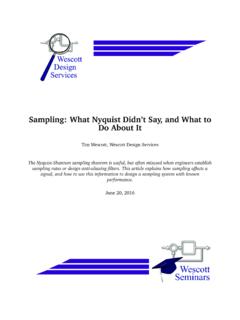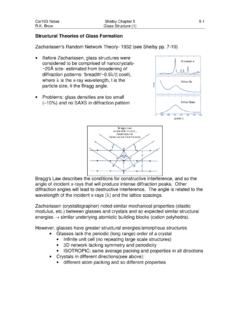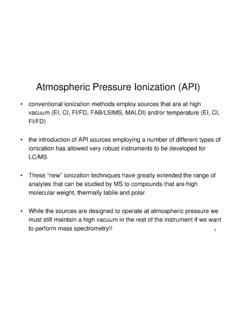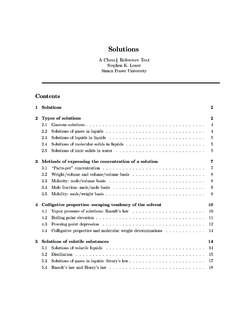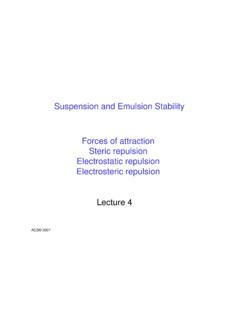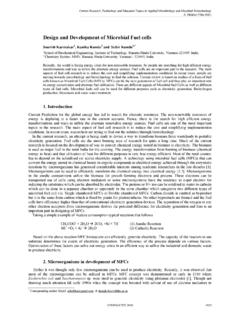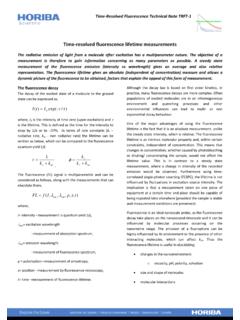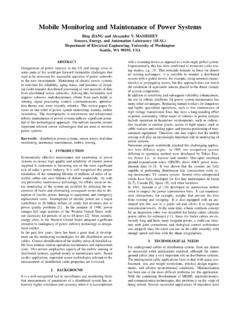Transcription of Controlling Motors in the Presence of Friction and …
1 Controlling Motors in the Presence of Frictionand BacklashTim Wescott, Wescott Design ServicesTwo of the most prevalent issues in Controlling moving mechanisms are Friction and effects are present in nearly every mechanism that one may wish to control, and theyhave a serious negative impact on the control system designer s ability to accurately controlmechanism motion, yet often they can be eliminated only through heroic efforts on the partof mechanism designers. Thus it is often necessary to deal with these effects in the article explains Friction and backlash effects, why they are a source of problems inmotion system design, how a control system designer can predict their effects and how tomitigate those 14, 2016 Controlling Motors in the Presence of Friction and BacklashAuthor s Note:This paper forms part of the basis material for Chapter 8,Nonlinear Systems, inthe bookApplied Control Theory for Embedded Systemsby Tim Wescott [Wes06].
2 If you find this paper informative, you may be interested in the rest of the Wescott1 Wescott Design ServicesControlling Motors in the Presence of Friction and BacklashFigure 1: Force vs. Velocity plot for smooth control in mechanisms can be a heartless task. Modeling is difficult, andcontrol strategies that work in textbook cases often fail to work in the real world. Twoof the factors that often contribute to this difficulty are Friction and backlash . These effectsare highly nonlinear, difficult to model and analyze even with a fully nonlinear model, yetcannot be , control systems engineers have developed methods of dealing with these is-sues.
3 These methods are ad-hoc and often seem old fashioned, but they can often workand work Friction and backlash BehaviorThe property that makes both Friction and backlash difficult to deal with is the existenceof sudden, difficult to quantify discontinuities. This not only makes it difficult to deal withtheir behavior mathematically, it also means that the performance of common PID and PDcontrollers will not be close to optimal, and will often not be is familiar with Friction in everyday life. Friction lets us stand and walk, it lets ushold tools and food, it makes our machines run. Friction also defeats our attempts to build100% efficient machines, and it can make life difficult for a control systems 1 on page 2 shows the main characteristics of a mechanical interface with stiction (or starting Friction ) is the amount of force required to break the interfaceloose.
4 The Coulombic (or dry ) Friction is that portion of the running Friction that isdependent only on the direction of motion but has constant magnitude. Finally mostmechanisms with Friction also display some viscous drag that is more or less proportionalto Wescott2 Wescott Design ServicesControlling Motors in the Presence of Friction and BacklashFigure 2: Input vs. Output Displacement for an Element with at Figure 1 there are not one, but two discontinuities around zero velocity. Firstthere s the Coulombic Friction , where the force resisting motion is proportional to the signof the velocity. If that weren t enough, most interfaces with Friction also exhibit stiction(or starting Friction ).
5 Stiction is the effect where, if the interface has remained still for anylength of time, the amount of force required to start the relative motion is greater thanthe amount required to sustain it. The resulting force/velocity relationship not only hasdiscontinuities in it, but it has discontinuities that are, for all effective purposes, large andinfinitesimally control systems terms the result of these discontinuities in the force/velocity relationshipis to give the relationship an effective gain that is effectively infinite. Worse, the effectivegain when the mechanism comes out of stiction is not only large but negative. Neither ofthese properties are conducive to loop the term that is commonly used to describe any sort of coupling that has slackwhen it is unloaded.
6 Devices such as gear trains, or mechanical linkages that containpinned hinges, will exhibit backlash to some extent or another. Such devices require acertain amount of running clearance to work, and this running clearance must be taken upbefore the output of the device will respond to the input. This all means that for a giveninput position the position of the output is indeterminate within the limits of the amount of backlash in any given mechanism can often be bought down by specifyingmore precise parts, or by building anti- backlash devices. However, doing so adds systemcost, makes the system more sensitive to wear, and often increases problems with 2 on page 3 shows that backlash presents problems to the would-be plant modelthat are nearly as severe as those presented by Friction .
7 In the case of backlash there is ahidden state the difference between the input and output positions. This state is onlyindependent of the input position when it is within the indeterminate region beyondTim Wescott3 Wescott Design ServicesControlling Motors in the Presence of Friction and BacklashFigure 3: Mechanism Model with Friction and region the hidden state is at its minimum or maximum value, and the output is pinnedto the input. This causes the plant model to have variable structure, with a discontinuoustransition between the free and pinned 3 on page 4 shows the mechanism model that will be used in this paper. The modelis in the context of a motor , however it could easily apply to any mechanism with frictionand backlash .
8 The motor armature velocity determines the Friction torque available. Thisfriction torque is subtracted from the applied torque. If there is any torque left over thisis used to accelerate the motor armature. The armature velocity is integrated into motorshaft position. The motor drives a device (usually a gearbox) that has some backlash ; theoutput of this device is the output of the motor Linear ControllersThe preferred way of designing a control system is to either start with a linear plant model,or linearize the model by choosing an operating point and finding the first derivative ofthe plant output to the important plant inputs.
9 Many control systems engineers are sofocused on a linearized model that they don t even realize that they ve done so that sjust the way things are done . This approach works in cases where the first derivativeexists and where it doesn t vary over too wide a range, and where the plant model doesn tdramatically change it s character as a function of it s state. In the case of Friction andbacklash, however, the plant s input-output behavior usually makes this method Continuous MotionOne use case for a controller where Friction and backlashdon tmake the linear approxima-tion invalid is when the system is in continuous motion. If the system to be controlled isgoing to be running continuously and in such a manner that the backlash is always takenup, then the behaviors shown by Figure 1 on page 2 and Figure 2 on page 3 will be re-duced to a fixed Friction torque and a fixed positional offset.
10 In this case then the systemTim Wescott4 Wescott Design ServicesControlling Motors in the Presence of Friction and Backlashbehavior can be modeled easily by linearization, and simple PID control techniques can beused quite 1: When Friction Isn t So motor is connected to a small conveyor belt, and is controlled by a PID con-troller connected to the motor via tachometer feedback as shown in Figure 4on page 5. The motor and conveyor assembly together have both Friction andbacklash, and behave as modeled in Figure 3 on page 4. When the assem-bly is in continuous motion its response to a torque disturbance is a dampedpass-band response which can be approximated by (s)Td(s)=kdss2+ 2 0s+ 20(1)where the damping ratio ( ) is no less than , the loop natural frequency( 0) is approximately14radians/sec, and the coupling constant at the motorkdisno more1than100 RPM/N m/sec(N m= Newton-meter).
